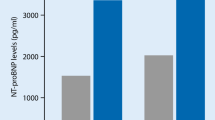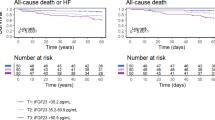Abstract
Purpose
Atrial fibrillation (AF) and acute congestive heart failure (aCHF) are characterized by an adverse cardiac remodeling. Arrhythmogenic or structural remodeling can be caused by interstitial fibrosis. Transforming growth factor beta 1 (TGF-beta 1) represents a central regulator of cardiac fibrosis. This study investigates serum levels of TGF-beta 1 in patients with AF and aCHF.
Methods
401 patients presenting with symptoms of dyspnea or peripheral edema were prospectively enrolled. Blood samples for measurement of TGF-beta 1 (R&D Systems, Inc.) and amino-terminal pro-brain natriuretic peptide (NT-proBNP) (DadeBehring ltd.) were collected after the initial clinical evaluation.
Results
Median TGF-beta 1 levels were lower in patients with AF (21.0 ng/ml, interquartile range (IR) 15.4–27.6 ng/ml, n = 107) compared to those without (25.0 ng/ml, IR 18.5–31.6 ng/ml, n = 294) (p = 0.009). Patients with aCHF had lower TGF-beta 1 levels (median 22.0 ng/ml, IR 15.6–27.1 ng/ml, n = 122) than those without (median 24.9 ng/ml, IR 18.1–31.9 ng/ml, n = 279) (p = 0.0005). In logistic regression models TGF-beta 1 was still associated with AF (odds ratio (OR) 3.00, 95% CI 1.37–6.61, p = 0.0001) and aCHF (OR 3.98, 95% CI 1.55–10.19, p = 0.004). TGF-beta 1 inversely correlated with left atrial diameter (r = −0.30, p = 0.007) and NT-proBNP (r = −0.14, p = 0.007).
Conclusions
Low serum levels of TGF-beta 1 are associated with AF and aCHF. This decrease may result from a higher consumption of TGF-beta 1 within the impaired myocardium or antifibrotic functions of natriuretic peptides.



Similar content being viewed by others
References
Kirchhof P, Bax J, Blomstrom-Lundquist C et al (2009) Early and comprehensive management of atrial fibrillation: proceedings from the 2nd AFNET/EHRA consensus conference on atrial fibrillation entitled ‘research perspectives in atrial fibrillation’. Europace 11:860–885
Horlitz M, Schley P, Shin DI et al (2008) Atrial tachycardias following circumferential pulmonary vein ablation: observations during catheter ablation. Clin Res Cardiol 97:124–130
Nitardy A, Langreck H, Dietz R et al (2009) Reduction of right ventricular pacing in patients with sinus node dysfunction through programming a long atrioventricular delay along with the DDIR mode. Clin Res Cardiol 98:25–32
Hauck M, Bauer A, Voss F et al (2009) Effect of cardiac resynchronization therapy on conversion of persistent atrial fibrillation to sinus rhythm. Clin Res Cardiol 98:189–194
Tebbe U, Oeckinghaus R, Appel KF et al (2008) AFFECT: a prospective, open-label, multicenter trial to evaluate the feasibility and safety of a short-term treatment with subcutaneous certoparin in patients with persistent non-valvular atrial fibrillation. Clin Res Cardiol 97:389–396
Watson T, Shantsila E, Lip GY (2009) Mechanisms of thrombogenesis in atrial fibrillation: Virchow’s triad revisited. Lancet 373:155–166
Opie LH, Commerford PJ, Gersh BJ et al (2006) Controversies in ventricular remodelling. Lancet 367:356–367
Dickstein K, Cohen-Solal A, Filippatos G et al (2008) ESC Guidelines for the diagnosis and treatment of acute and chronic heart failure 2008: the task force for the diagnosis and treatment of acute and chronic heart failure 2008 of the European Society of Cardiology. Developed in collaboration with the Heart Failure Association of the ESC (HFA) and endorsed by the European Society of Intensive Care Medicine (ESICM). Eur Heart J 29:2388–2442
Dagli N, Karaca I, Yavuzkir M et al (2008) Are maximum P wave duration and P wave dispersion a marker of target organ damage in the hypertensive population? Clin Res Cardiol 97:98–104
Plisiene J, Blumberg A, Haager G et al (2008) Moderate physical exercise: a simplified approach for ventricular rate control in older patients with atrial fibrillation. Clin Res Cardiol 97:820–826
Towbin JA (2007) Scarring in the heart—a reversible phenomenon? N Engl J Med 357:1767–1768
Blobe GC, Schiemann WP, Lodish HF (2000) Role of transforming growth factor beta in human disease. N Engl J Med 342:1350–1358
Akinci B, Bayraktar F, Saklamaz A et al (2007) Low transforming growth factor-beta1 serum levels in idiopathic male osteoporosis. J Endocrinol Invest 30:350–355
Stefoni S, Cianciolo G, Donati G et al (2002) Low TGF-beta1 serum levels are a risk factor for atherosclerosis disease in ESRD patients. Kidney Int 61:324–335
Gordon KJ, Blobe GC (2008) Role of transforming growth factor-beta superfamily signaling pathways in human disease. Biochim Biophys Acta 1782:197–228
Khan R, Sheppard R (2006) Fibrosis in heart disease: understanding the role of transforming growth factor-beta in cardiomyopathy, valvular disease and arrhythmia. Immunology 118:10–24
Clarke DC, Liu X (2008) Decoding the quantitative nature of TGF-beta/Smad signaling. Trends Cell Biol 18:430–442
Weber KT (1997) Extracellular matrix remodeling in heart failure: a role for de novo angiotensin II generation. Circulation 96:4065–4082
Behnes M, Brueckmann M, Ahmad-Nejad P et al (2009) Diagnostic performance and cost effectiveness of measurements of plasma N-terminal pro brain natriuretic peptide in patients presenting with acute dyspnea or peripheral edema. Int J Cardiol 135:165–174
Behnes M, Lang S, Breithardt OA et al (2008) Association of NT-proBNP with severity of heart valve disease in a medical patient population presenting with acute dyspnea or peripheral edema. J Heart Valve Dis 17:557–565
Camm AJ, Kirchhof P, Lip GY et al (2010) Guidelines for the management of atrial fibrillation: the task force for the management of atrial fibrillation of the European Society of Cardiology (ESC). Eur Heart J 31:2369–2429
Hanley JA, McNeil BJ (1983) A method of comparing the areas under receiver operating characteristic curves derived from the same cases. Radiology 148:839–843
Corda S, Samuel JL, Rappaport L (2000) Extracellular matrix and growth factors during heart growth. Heart Fail Rev 5:119–130
Leask A (2007) TGFbeta, cardiac fibroblasts, and the fibrotic response. Cardiovasc Res 74:207–212
Zeisberg EM, Tarnavski O, Zeisberg M et al (2007) Endothelial-to-mesenchymal transition contributes to cardiac fibrosis. Nat Med 13:952–961
Xiao H, Zhang YY (2008) Understanding the role of transforming growth factor-beta signalling in the heart: overview of studies using genetic mouse models. Clin Exp Pharmacol Physiol 35:335–341
Everett THt, Olgin JE (2007) Atrial fibrosis and the mechanisms of atrial fibrillation. Heart Rhythm 4:S24–S27
Li X, Ma C, Dong J et al (2008) The fibrosis and atrial fibrillation: is the transforming growth factor-beta(1) a candidate etiology of atrial fibrillation. Med Hypotheses 70:317–319
Lim H, Zhu YZ (2006) Role of transforming growth factor-beta in the progression of heart failure. Cell Mol Life Sci 63:2584–2596
MacLellan WR (2000) Advances in the molecular mechanisms of heart failure. Curr Opin Cardiol 15:128–135
Xu J, Cui G, Esmailian F et al (2004) Atrial extracellular matrix remodeling and the maintenance of atrial fibrillation. Circulation 109:363–368
Lin CS, Pan CH (2008) Regulatory mechanisms of atrial fibrotic remodeling in atrial fibrillation. Cell Mol Life Sci 65:1489–1508
Du J, Xie J, Zhang Z et al (2010) TRPM7-mediated Ca2+ signals confer fibrogenesis in human atrial fibrillation. Circ Res 106:992–1003
Nishikimi T, Maeda N, Matsuoka H (2006) The role of natriuretic peptides in cardioprotection. Cardiovasc Res 69:318–328
Ogawa Y, Tamura N, Chusho H et al (2001) Brain natriuretic peptide appears to act locally as an antifibrotic factor in the heart. Can J Physiol Pharmacol 79:723–729
Letsas KP, Filippatos GS, Pappas LK et al (2009) Determinants of plasma NT-pro-BNP levels in patients with atrial fibrillation and preserved left ventricular ejection fraction. Clin Res Cardiol 98:101–106
Li P, Wang D, Lucas J et al (2008) Atrial natriuretic peptide inhibits transforming growth factor beta-induced Smad signaling and myofibroblast transformation in mouse cardiac fibroblasts. Circ Res 102:185–192
Quantikine®, Human TGFbeta 1 Immunoassay,©2008. R&D Systems Inc., Minneapolis; Available at: http://www.rndsystems.com/pdf/DB100B.pdf
Dobrev D (2010) Atrial Ca2+ signaling in atrial fibrillation as an antiarrhythmic drug target. Naunyn Schmiedebergs Arch Pharmacol 381:195–206
Dobrev D,Nattel S (2008) Calcium handling abnormalities in atrial fibrillation as a target for innovative therapeutics. J Cardiovasc Pharmacol 52:293–299
Author information
Authors and Affiliations
Corresponding author
Additional information
M. Behnes and U. Hoffmann contributed equally to this study.
M. Brueckmann is an employee of Boehringer Ingelheim GmbH and a lecturer of the Medical Faculty of Mannheim, University of Heidelberg, Germany.
Rights and permissions
About this article
Cite this article
Behnes, M., Hoffmann, U., Lang, S. et al. Transforming growth factor beta 1 (TGF-beta 1) in atrial fibrillation and acute congestive heart failure. Clin Res Cardiol 100, 335–342 (2011). https://doi.org/10.1007/s00392-010-0248-1
Received:
Accepted:
Published:
Issue Date:
DOI: https://doi.org/10.1007/s00392-010-0248-1




